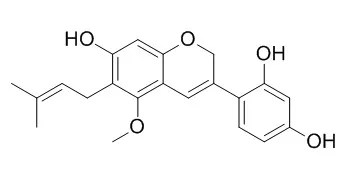| Kinase Assay: |
| Mol Carcinog. 2016 May;55(5):552-62. | | Dehydroglyasperin C suppresses TPA-induced cell transformation through direct inhibition of MKK4 and PI3K.[Pubmed: 25787879 ] | Bioactive natural compounds from plant-derived sources have received substantial interest due to their potential therapeutic and preventive effects toward various human diseases. Licorice (Glycyrrhiza), a frequently-used component in traditional oriental medicines, has been incorporated into recipes not only to enhance taste, but also to treat various conditions including inflammation, chronic fatigue syndrome, and even cancer. Dehydroglyasperin C (DGC) is a major isoflavone found in the root of licorice.
METHODS AND RESULTS:
In the present study, we investigated the cancer chemopreventive effect of DGC and the underlying molecular mechanisms involved, by analyzing its effects on 12-O-tetradecanoylphorbol-13-acetate (TPA)-induced neoplastic cell transformation and cyclooxygenase (COX)-2 expression in JB6 P+ mouse epidermal cells. DGC treatment attenuated TPA-induced activator protein-1 (AP-1) and nuclear factor-κB (NF-κB) transcriptional activation, two major regulators of TPA-induced cell transformation, and COX-2 expression. TPA-induced phosphorylation of p38, JNK1/2 and Akt was also suppressed by DGC. Kinase assay data revealed that DGC inhibited the kinase activity of MKK4 and PI3K and this outcome was due to direct physical binding with DGC. Notably, DGC bound directly to MKK4 and PI3K in an ATP-competitive manner.
CONCLUSIONS:
Taken together, these results suggest that DGC exhibits cancer chemopreventive potential via its inhibitory effect on TPA-induced neoplastic cell transformation and COX-2 modulation through regulation of the MKK4 and PI3K pathways. | | J Agric Food Chem. 2012 Jun 6;60(22):5583-9. | | Neuroprotective effects of dehydroglyasperin C through activation of heme oxygenase-1 in mouse hippocampal cells.[Pubmed: 22578244 ] | Licorice, the root of the Glycyrrhiza species ( Glycyrrhiza uralensis Fisher), is known to have antioxidant, anti-inflammatory, antiviral, and antitumor properties. The objective of this study is to explore the neuroprotective effect of Dehydroglyasperin C (DGC) against glutamate-induced oxidative stress in mouse hippocampal HT22 cells.
METHODS AND RESULTS:
DGC significantly reduced cytotoxicity and reactive oxygen species (ROS) generation induced by glutamate in HT22 cells, whereas DGC did not restore glutathione depletion caused by glutamate. In addition, it was further investigated whether DGC affected the expression of heme oxygenase (HO)-1, one of the major cellular antioxidant defense systems, and it was found that DGC dose-dependently increased HO-1 expression. DGC-mediated cytoprotection of HT22 neuronal cells from glutamate insult was abrogated by either HO-1 inhibitor (Tin protoporphyrin, SnPP) or AKT inhibitor (LY294002).
CONCLUSIONS:
In conclusion, the present results demonstrate for the first time that DGC protects neuronal cells against glutamate-induced oxidative injury through the induction of HO-1 expression, which is, in turn, activated maybe through Nrf2-Keap1 and PI3K/AKT signaling pathways. | | J Agric Food Chem. 2010 Feb 10;58(3):1603-8. | | Dehydroglyasperin C isolated from licorice caused Nrf2-mediated induction of detoxifying enzymes.[Pubmed: 20088509 ] |
METHODS AND RESULTS:
Our preliminary experiment demonstrated that a n-hexane/EtOH (9:1, volume) extract of Glycyrrhiza uralensis (licorice) caused a significant induction of NAD(P)H:oxidoquinone reductase (NQO1), one of the well-known phase 2 detoxifying enzymes.
We isolated Dehydroglyasperin C (DGC) as a potent phase 2 enzyme inducer from licorice. DGC induced NQO1 both in wild-type murine hepatoma Hepa1c1c7 and ARNT-lacking BPRc1 cells, indicating that the compound is a monofunctional inducer.
CONCLUSIONS:
The compound induced not only NQO1 but also some other phase 2 detoxifying/antioxidant enzymes, such as glutathione S-transferase, gamma-glutamylcysteine synthase, glutathione reductase, and heme oxygenase 1. Similar to most monofunctional inducers, DGC caused the accumulation of Nrf2 in the nucleus in dose- and time-dependent manners and thereby activated expression of phase 2 detoxifying enzymes. It also resulted in a dose-dependent increase in the luciferase activity in the reporter assay, in which HepG2-C8 cells transfected with antioxidant response element (ARE)-luciferase construct were used, suggesting that the induction of phase 2 detoxifying and antioxidant enzymes could be achieved through the interaction of Nrf2 with the ARE sequence in the promoter region of their genes. |
|






 Cell. 2018 Jan 11;172(1-2):249-261.e12. doi: 10.1016/j.cell.2017.12.019.IF=36.216(2019)
Cell. 2018 Jan 11;172(1-2):249-261.e12. doi: 10.1016/j.cell.2017.12.019.IF=36.216(2019) Cell Metab. 2020 Mar 3;31(3):534-548.e5. doi: 10.1016/j.cmet.2020.01.002.IF=22.415(2019)
Cell Metab. 2020 Mar 3;31(3):534-548.e5. doi: 10.1016/j.cmet.2020.01.002.IF=22.415(2019) Mol Cell. 2017 Nov 16;68(4):673-685.e6. doi: 10.1016/j.molcel.2017.10.022.IF=14.548(2019)
Mol Cell. 2017 Nov 16;68(4):673-685.e6. doi: 10.1016/j.molcel.2017.10.022.IF=14.548(2019)